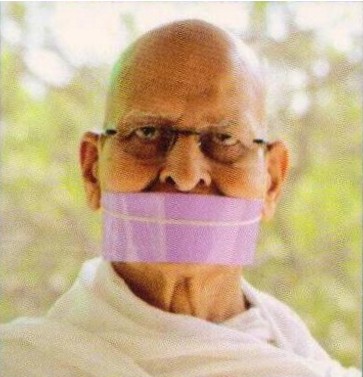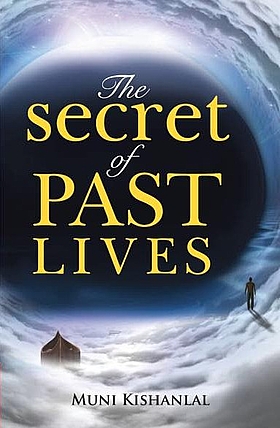The truth is that we live because there is life. This cannot be denied. One cannot negate the experience of the present as it is nothing but truth. What is present, becomes past and future, becomes present. The present, past and future are interlinked. If the past is true then present and future have to be accepted. Those who disagree argue that what we do not know or what we have not seen cannot be agreed upon. According to this argument how can that which is neither seen nor experienced be accepted? This is a tricky question. If we say yes we have to prove it and if we say no we have to disprove it. Therefore the fact is that we must believe that if there is a present then there must have been a past and the present will give way to future because there can be no present without future. One cycle has past, present and future. Just as the day has three stages - morning, noon and evening these are the stages similarly of the soul's cycle of previous birth, present status and rebirth.
What we witness in the present is absolute truth. Once we analyze the time scale it is clear that there is a present and there is a future. It makes very clear that there must be a past also. When future precedes present the present becomes past. In other words the present gives birth to past. The consequences of present justify the existences of the matter. If we believe in inanimate objects then we have to believe in the existence of the animate. The word inanimate has the word animate in it which means what seems to be inanimate must have been animate. Animate becomes inanimate after death. Tree is animate and once it withers it becomes inanimate. Human body is animate but after death it becomes inanimate.
The belief is common but scientists need more proof. If after the death the soul could return to say I have that I am suffering now because of the evil deeds I did when I was alive, then perhaps there would be proof. A question, similar in nature, was raised by Raja Pradeshi to Acharya Shri Keshi.
"My grandfather was very cruel. He would eat food without even cleaning the hands after he had murdered someone. According to you he must have gone to hell. Let him come and tell me, 'Dear grandson, I am suffering the consequences of my cruelty. Then I would stop committing any act of cruelty."
"Raja Pradeshi, thought for a while. Suppose someone misbehaves with your wife, the Queen Suryakanta, and if he is caught by your guard you pronounced a death sentence. While taking him for execution if he comes across a temple and requests that he may be allowed to pray will the executioners leave him? No. Similarly, the ruler of hell, will not allow them to return. They are made to suffer and cannot return even if they want to."
"O wise One, it is clear that the ruler of hell does not allow people to come back. But my grandmother was very religious. She used to be engaged right from morning till evening in all religious rites and rituals, meditation and ceremonies. In her last stage she starved herself to death. According to your theory she must be in heaven. She must have been born an angel. If she could at least once tell me, "O my grandchild I am in heaven, I am experiencing bliss. See, I was righteous so I am enjoying the heavenly bliss. You should also leave this cruelty and be righteous so you can enjoy heavenly bliss. But she also did not appear. How can we believe that there is heaven and hell. I am sure this is all just a figment of imagination popularized by the so-called Acharyas who assert that they are custodians of religion. There is neither hell nor heaven. If there was then she would definitely tell me."
"Raja Pradeshi these people are so engrossed in their world that it takes hundreds of years for them to even think of coming to the world. Even if they wish to come in to the world, they feel unhappy to see the world that is a place of all kinds of sins that are committed that they wish to remain away from this world very much like you who would like to from a place of stink while you are intent on visiting a temple."
"O great master I have tried many experiments. I gave death sentence to a thief. If the soul does leave the body, then it must be escaping through a hole? I ordered that the thief be put in an iron box. After some time when he was removed he was dead but there was no sign of any hole to establish the fact that the soul had left the body. How did the soul leave?"
"O King, when a drum is beaten in a closed room, does its sound not travel out too? Sound is gross as compared to the soul, which is even more subtle. It has no form. Hence what difficulty can the soul have to escape from a closed room?"
Raja gave another example. He said, 'I ordered that the thief be chopped into pieces but I could not see the soul.'
The Acharya said, "Your thoughts are very strange. You talk like that stupid woodcutter who searched for fire by cutting wood into tiny pieces and he could not find any fire. His friends had told him that they were going to the forest to collect firewood and they had wanted him to make fire from wood and start cooking. They assured him that they would give him share of the wood they had cut. When he heard his friends coming back he shouted in a peeved manner, "You told me to get fire from wood and I have chopped wood to its smallest piece and yet have not found fire. " You seem to be like the woodcutter trying to find the soul by cutting the body to pieces."
The king was defeated by the Acharya in the debate. With the acceptance of the existence of the soul, he reconciled himself with the idea of previous birth and rebirth. On listening to the Muni, the disciple underwent 12 vows and became his disciple. Thus Raja Pradeshi, took the path of penance. Thus the king realized that he could no more be selfish, self-centred or egoist. If he could not satisfy the desires of his queen, Suryakanta he instead of greater attachment became more detached. What was beloved became the killer. It is difficult to swallow food that is mixed with poison, but with equanimity he embraced the idea of leaving the body. The path of spiritual realization that the king had decided to follow, moved him further with great determination and alertness.
Jain Agamas have many instances that relate to a previous birth and/ or rebirth. In the Dasavaikalik there is a passage on why the soul keeps taking rebirth in one body or other. Who is watering this huge Banyan tree of life and death and rebirth? Giving the solution to this, the Agamas say:
Koh o yam ano ya anniggahiya, maya ya lobho ya pavaddhamana
Chattari e e kasina kashaya, sinchanti mulaim punnabbhavassa
That is: Anger, ego, delusion and greed are the four kashyas that cause rebirth. As long as these emotions keep growing, rebirth will be definite... the cycle of life will continue.
The theory of rebirth is very ancient and is the greatest discovery of Indian culture. Vedas, Jainism and Buddhism have accepted the tenets of rebirth. According to Vedic traditions God is creator. But at the same time it is said, Karma adheen sabhi rachi rakha... Karma Yog' is the existential truth, the how does God mete out punishment? The question arises when and how did God create? Along with this another question arises, who created God? If he is self made, swayambhu then why can we not think of all creation as swayambhu? If rebirth is according to one's own deeds then what is the role of God, the creator? These questions belong to the realm of philosophy. Philosophers have written volumes on this. They have spent thousands of hours in discussion and debate. Why should we get into these problems and arguments. On what grounds Vedic tradition have analyzed the concept of rebirth and previous birth. Let us discuss this briefly.
According to Vedic tradition there is life after death. The one who is reborn must have had a life prior to this and then a previous birth.
According to 'Kathopanishad', young Nachiketa asks Yama about life and death, without the existence of the soul, who is it who will be reborn? A soul is born in a human body after traversing through 84 lakhs births in different shapes. Only if there is rebirth can one traverse through so many births.
In the Gita Sri Krishna says:
'Yada yada hi dharmasya glanirbhavati bharata
Abhuythanamdharmasya tadatmanam srijayaham
Pritranaay sashunam vinashaay cha dushdritam
Dharmasansthapanarthaya sambhavami yuge yuge'
Whenever and wherever there is decline of dharma and a predominant rise of adharma at that time I manifest, time and again.
These lines are also evocative of rebirth.
There are many discussions in the Vedic tradition on past lives and rebirth. If there was no rebirth then of what use would all our prayers, penance etc. be? They bring rewards and so they are practiced. Along with how will we repent our ill deeds of previous births? To negate rebirth and past lives is to negate our own existence. The Vedic tradition accepts of consciousness and repeated births.
The Gita presents the idea comprehensively. Commentator, Yogbhrasht Sadak writes:
Shuchinam shrimatam gehe yogbhrashto abhijayate Athva yoginameva kule bhavati dhimtaam
That is: Yogabhrasht Sadak is born in an affluent and respected household, that is in the house of an intelligent man.
One experiences the good and bad of the previous birth in this birth. The aspects in the environment at birth are indicative of the previous birth. This is proved in the following shloka of the Gita:
Tatra tam buddhisamyogam labhate paurvadehikam
Yatate cha tato bhuyaha samsiddhow kurunandan
That is: Acquiring the traits of his previous birth, he again tries for moksha. When bad deeds have been committed rebirth will take place in the following categories says Sri Krishna:
Tanhamdwishataha kruran sansareshu naradhman
Ksipamyajasarmshubhanasurishveva yonishu
Those who perform bad, uncompassionate deeds I cause to be born as asuras.
The Gita thus confirms that there is rebirth and it is in accordance with one's actions and karmas thus accumulated.
 Muni Kishan Lal
Muni Kishan Lal
